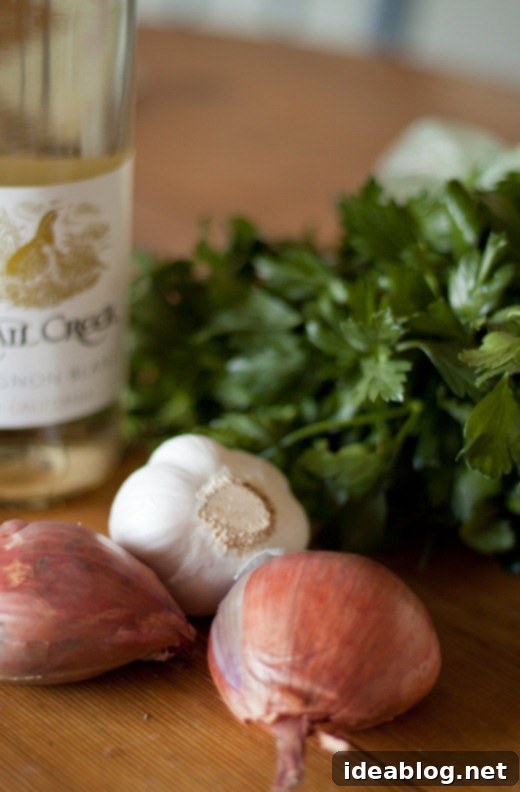Classic Moules Frites: Your Ultimate Guide to Perfect Mussels & Homemade Fries
Classic Moules Frites, an iconic and deeply satisfying dish, features succulent mussels steamed to perfection in a flavorful broth of shallots, garlic, white wine, and a touch of cream and parsley, traditionally served alongside crispy homemade French fries. This comprehensive guide will equip you with all the knowledge needed to master this beloved Belgian and French bistro staple in your own kitchen.
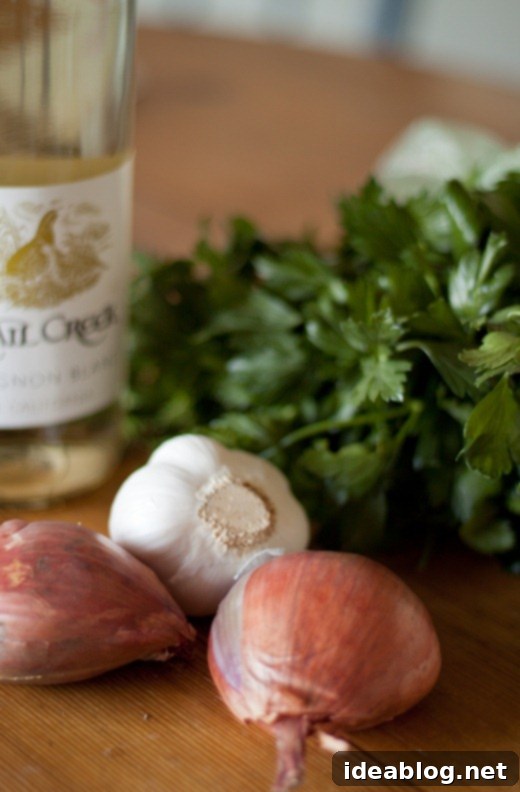
Moules Frites, a delightful combination of steamed mussels and crisp French fries, holds a special place in the culinary world for very good reasons. Originating from Belgium but equally cherished in France, this dish offers a unique blend of sophisticated flavors and comforting textures that appeals to nearly everyone. It’s a meal that feels both gourmet and incredibly approachable, making it a perfect choice for anything from a casual weeknight dinner to an impressive dinner party.
While the plump, tender mussels are undoubtedly the star protein, the true magic often lies in the rich, aromatic cooking broth. This flavorful liquid, infused with savory shallots, pungent garlic, bright white wine, and sometimes a hint of luxurious cream, is what elevates the dish from simple seafood to an unforgettable experience. The accompanying side of perfectly salted, golden French fries isn’t just an afterthought; it’s a crucial component, acting as the ideal vehicle for soaking up every last drop of that delectable sauce. If you’re looking for an alternative, a crusty slice of sourdough bread works equally well. The more ways you have to enjoy that exquisite broth, the better!
There’s little doubt that the genius behind this incredible pairing deserves immense credit (we owe a great debt to Belgian culinary tradition!). While many are already convinced of Moules Frites’ deliciousness, the idea of preparing it from scratch at home might still seem daunting. However, you’ll discover that making this bistro classic in your own kitchen is far easier and more rewarding than you might imagine.
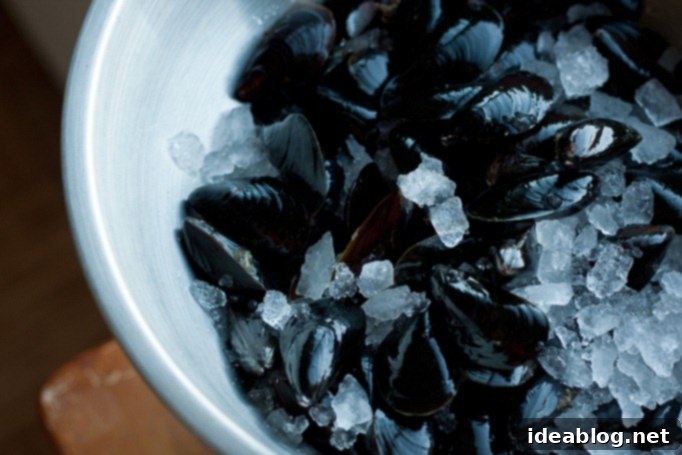
Mussels are often surprisingly quick to cook, making them an excellent option for fast, flavorful meals. Beyond their rapid cooking time, they are also an incredibly affordable seafood choice and require only a handful of staple ingredients to transform into a gourmet experience. This makes them a fantastic protein source that’s both economical and delicious for any home cook.
Despite their many advantages, the preparation of mussels can indeed feel a bit intimidating, especially for those new to cooking with shellfish. Concerns about proper cleaning, safe storage, whether or not to soak them, and the often-mysterious process of de-bearding can cause hesitation. And, of course, there’s the ever-present anxiety of encountering and consuming a “bad” mussel. These concerns are valid, and unfortunately, many mussel recipes gloss over these crucial preparatory steps, simply stating “mussels, cleaned and de-bearded” in the ingredient list, as if these tasks magically complete themselves.
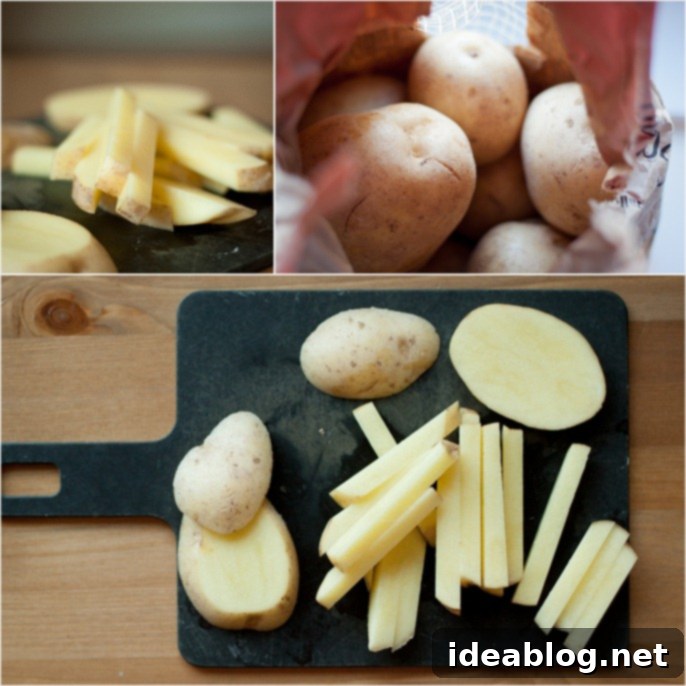
To demystify the process and make preparing this delightful dish easier and more enjoyable for you, we’ve compiled our best mussel buying, cleaning, and cooking tips. With these insights, you’ll feel confident tackling Moules Frites at home, ensuring a safe, delicious, and truly satisfying culinary adventure.
Essential Tips for Buying Mussels for Your Moules Frites
- Purchase on the Day of Cooking: Shellfish, especially mussels, are best when incredibly fresh. Plan to buy your mussels on the same day you intend to cook them. This ensures optimal flavor and safety. While they can sometimes be stored for a day, same-day preparation is always preferred.
- Loose vs. Bagged Mussels: Most grocery stores will offer mussels either in pre-packaged mesh bags by weight or loose in a display case. Pre-packaged bags often appear to be cheaper per pound, but be wary. These bags can sometimes contain a higher percentage of cracked shells or dead mussels, which will need to be discarded, ultimately reducing your usable yield. For this reason, I personally prefer to buy mussels loose. If you do opt for bagged mussels, consider purchasing an additional 1/2 pound or so to account for any that may not be suitable for cooking.
- Selecting Healthy Mussels: When purchasing loose mussels, you’ll have the advantage of hand-picking them. This is crucial for ensuring quality. Always choose mussels that are tightly closed. If a shell is slightly open, tap it gently; if it’s alive, it should slowly close. Discard any mussels that remain open or have visible cracks, chips, or broken shells. Additionally, good mussels should feel heavy for their size, indicating they are full of meat and liquid.
- Determining Serving Size: As a general rule of thumb, if you’re planning to serve Moules Frites as a main course, aim to purchase roughly 1 pound (approximately 450 grams) of mussels per serving. This usually provides a generous portion of shellfish.
- Proper Home Storage: Once you bring your mussels home, it’s vital to store them correctly to maintain their freshness and keep them alive until cooking. Immediately remove them from their bag, give each mussel a brief rinse under cold running water, and then thoroughly dry them on a clean kitchen linen or paper towels. Transfer the dry mussels to a shallow bowl, ensuring they are not submerged in water, and place them immediately in the refrigerator. Storing mussels in stagnant water will cause them to die quickly. Another excellent option is to store them over ice; however, be sure to use a setup that allows for proper drainage of any melting ice, preventing the mussels from sitting in water. Cover them loosely with a damp cloth or paper towel to keep them moist without suffocating them.
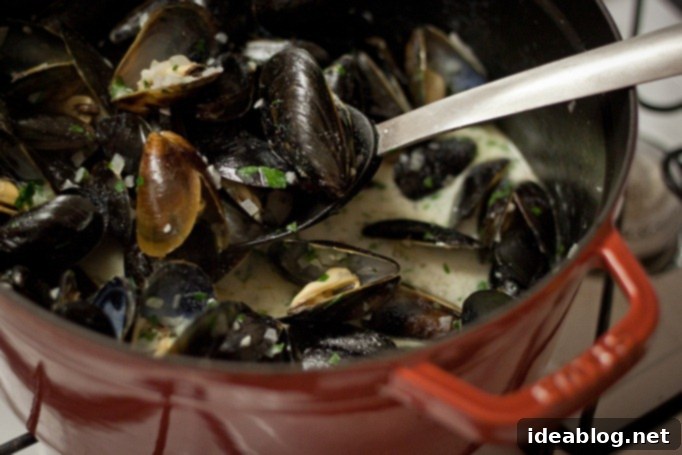
Detailed Tips for Cleaning and Prepping Mussels
- Checking for Life: Mussels, being living organisms, might open slightly once stored in the refrigerator as they relax. It’s important to confirm they are still alive before cooking. If you encounter an open mussel, tap its shell several times with your forefinger. If the mussel is alive and healthy, its shell should slowly but surely close. If it doesn’t react at all and remains open, it is most likely dead and should be discarded immediately. Never cook or eat dead mussels.
- To Soak or Not to Soak: There is a lively debate among chefs and home cooks regarding whether mussels should be soaked in water to remove grit and sand. Some culinary experts argue that this step is largely unnecessary, especially for most commercially available farm-raised mussels, which are often cultivated in conditions that minimize grit. Others prefer to always perform this step, regardless of the mussels’ origin, believing it ensures a cleaner product. Personally, I find soaking mussels in cold water for approximately 10 minutes to be beneficial. After this brief soak, I carefully scoop out the mussels and transfer them to a dry bowl. This process consistently leaves behind a bowl of cloudy, sometimes gritty water, which suggests that the soaking indeed helps to purge any lingering impurities.
- Thorough Scrubbing and Rinsing: After soaking (if you choose to do so), or just before cooking, scrub each individual mussel under cold tap water. Use a stiff brush or a clean scouring pad to remove any excess grit, barnacles, or other dirt attached to the shells. This step is critical for a clean eating experience. These cleaning steps can be done a few hours ahead of cooking if properly stored afterwards.
- The Art of De-Bearding: The process of de-bearding is often misunderstood but simple once you know how. The “beard” refers to the stringy, brown fibers that protrude from the side of the mussel near the hinge. These are byssal threads, which mussels use to anchor themselves to rocks or other surfaces. It’s important to de-beard mussels only about 10 to 15 minutes before you intend to cook them. De-bearding too early can weaken the mussel and potentially cause it to die prematurely, as the beard is intimately attached to the mussel’s body. To remove the beard, firmly grasp the strings between your thumb and forefinger and yank them sharply towards the hinge (the point where the two shells connect). Pulling in the opposite direction can tear the mussel’s flesh and kill it. For particularly stubborn beards, you can use pliers or fish tweezers to get a better grip. While it’s ideal to remove all beards, if one or two prove incredibly difficult to remove, it’s not the end of the world, but it’s best to avoid eating those particular strands if they detach during cooking.
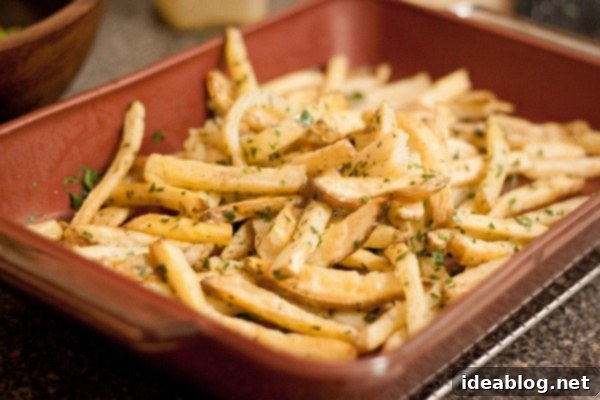
Now that we’ve thoroughly covered the essential steps for shopping for, cleaning, and preparing your mussels, let’s dive into the Moules Frites recipe itself! This recipe presents a very classic and beloved preparation of mussels, where the shellfish are gently cooked in a rich, aromatic broth. The foundation of this exquisite broth is built upon sautéed shallots and garlic, deglazed with a generous splash of dry white wine. A touch of heavy cream is then introduced to provide a luscious richness and silky texture, while fresh parsley is added at the end for vibrant brightness and a beautiful pop of color.
To truly complete this authentic experience, I wholeheartedly recommend serving these delectable mussels with homemade oven-baked fries. These aren’t just a convenient alternative; when prepared correctly, they can be every bit as crispy and satisfying as their deep-fried counterparts, yet they are significantly easier and less messy to prepare at home. The key is a good soak and a proper bake, yielding golden, fluffy-on-the-inside, crispy-on-the-outside perfection. And as mentioned, if fries aren’t your preference, a robust, crusty bread is another fantastic choice. Just ensure you have *something* on hand to generously soak up every last drop of that incredibly flavorful cooking broth – it’s too good to let go to waste!
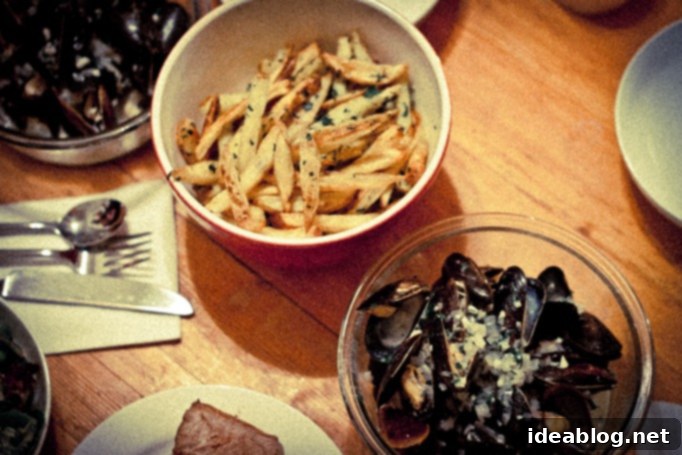

Classic Moules Frites
Pin
Review
SaveSaved!
Ingredients
For the Crispy Oven-Baked Fries:
- 1½-2 lbs Yukon Gold potatoes sliced into ½-inch wide batons (skin-on for extra flavor and texture)
- 3 tablespoons extra virgin olive oil
- kosher salt to taste
- freshly ground black pepper to taste
- ¼ cup flat leaf parsley leaves finely chopped, for garnish
For the Mussels:
- 2 tablespoons unsalted butter
- 1 tablespoon extra virgin olive oil
- 2 large shallots finely minced (approximately 5 ounces)
- 6 garlic cloves finely minced (roughly 2 tablespoons)
- 1 cup (240 mL) dry white wine (such as Sauvignon Blanc or Pinot Grigio)
- ½ cup (120 mL) heavy cream
- 2 lbs fresh mussels cleaned and de-bearded according to the tips above
- ½ cup flat leaf parsley leaves finely chopped
Instructions
For the Crispy Oven-Baked Fries:
-
Prepare Potatoes: Preheat your oven to a robust 450°F (230°C) with an oven rack positioned in the center. Carefully slice the Yukon Gold potatoes lengthwise into uniform ½-inch wide batons, resembling thick matchsticks. Leave the skin on for added rustic charm and nutritional value. Place the cut potatoes into a large bowl and cover them with cold water to soak for at least 30 minutes. This crucial step helps remove excess starch, which is key for achieving truly crispy fries.
-
Par-Cook Potatoes: After soaking, drain the potatoes thoroughly and transfer them to a large soup pot. Cover the potatoes with fresh cold water, ensuring the water level reaches 1 to 2 inches above the potatoes. Place the pot over high heat and bring the water to a gentle simmer. Cook the potatoes until they are almost entirely tender but still hold their shape – they should be just barely pierced with a knife, offering some slight resistance. Be careful not to overcook them, or they will become mushy and fall apart.
-
Drain and Season: Gently and carefully drain the par-cooked potatoes in a colander. Immediately transfer them onto several layers of stacked kitchen linens or paper towels and pat them thoroughly dry. Any residual moisture will prevent them from crisping. Brush a half sheet pan generously with 2 tablespoons of extra virgin olive oil. Add the dried potatoes to the pan, drizzle with the remaining olive oil, and toss gently until they are evenly coated. Spread the potatoes out into a single, even thin layer on the sheet pan, ensuring they are not overcrowded. Season generously with kosher salt and freshly ground black pepper.
-
Bake to Perfection: Bake the fries for 25 to 35 minutes, or until they are beautifully crispy and golden brown on all sides. Make sure to toss them halfway through the cooking time to ensure even browning and crispiness. Once baked, remove the pan from the oven and place it on a wire rack to cool slightly. Taste and adjust seasoning with additional salt and pepper if needed. Toss the hot fries with the finely chopped parsley for a burst of fresh flavor and serve them immediately while they are at their crispiest.
For the Mussels:
-
Sauté Aromatics: In a large Dutch oven or a wide-bottomed pot (which provides more surface area for the mussels to steam evenly), heat the unsalted butter and extra virgin olive oil over medium-low heat. Add the finely minced shallots and cook, stirring frequently, for 5-7 minutes until they are very soft, translucent, and fragrant, but not browned. Add the finely minced garlic and continue to cook for an additional minute, stirring constantly, until the garlic is aromatic.
-
Steam Mussels: Pour in the dry white wine and heavy cream, bringing the mixture to a gentle boil. Once boiling, add the cleaned and de-bearded mussels directly into the pot. Immediately cover the pot with a tight-fitting lid. Cook the mussels for approximately 5 to 7 minutes, stirring gently once or twice during the cooking process to ensure even steaming. The mussels are done when their shells have fully opened. Discard any mussels that do not open during cooking, as they were likely dead before cooking. Stir in the finely chopped parsley, gently incorporating it into the broth and mussels. Serve the Moules Frites immediately, ensuring each serving gets a generous helping of the flavorful broth. Enjoy with your crispy oven-baked fries or crusty bread!
